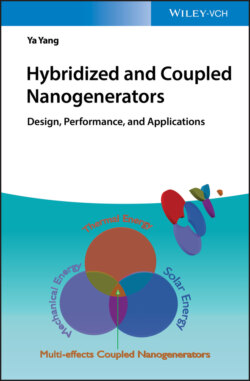Читать книгу Hybridized and Coupled Nanogenerators - Ya Yang - Страница 34
2.3.2.3 Polymer
ОглавлениеPolymers, such as PTFE, FEP, and PDMS, are ideal triboelectric materials for TENGs due to the flexibility and the excellent dielectric property. The surface roughness and environmental stability of the polymers in the TENGs can be enhanced with many advanced methods, such as plasma (ICP)‐reactive ion etching, template method, and 3D printed method. PDMS possesses a great deal of advantages, such as flexibility, transparency, and high electronegativity, and can be easily produced in special shapes. To study the influence of the surface morphology for the TENG, Dudem et al. developed functional polydimethylsiloxane (NpA‐PDMS) layers by soft imprint lithography [62]. The prepared layers possessed nanopillar‐like architectures, which could be used to increase the output voltage of the TENG.
PTFE is a common negative triboelectric material, exhibiting strong electron‐attracting ability and excellent flexibility. Guo et al. utilized inductively coupled plasma (ICP) ion etching to produce nanostructures on the PTFE film [63]. The fabricated PTFE film could form more charges when it made contact with the electrode, resulting in high output performance of the TENG. Wang et al. fabricated sponge‐like porous PTFE thin films by using deionized (DI) water as the soft template [64]. Compared with that based on flat PTFE film, the output performance based on porous PTFE thin film was obviously enhanced. Zhao et al. fabricated polytetrafluoroethylene/polyethene oxide (PTFE/PEO) membranes by using electrospinning method. In order to further enhance the charge density on the composite membranes, they introduced a high amount of stable static negative charges on the surface of the membranes [65].
Figure 2.7 Superhydrophobic surfaces on the Al substrates. (a) SEM image of the polished Al substrate. (b) High magnification SEM image of the polished Al substrate. (c) Image of the contact angle of water on the polished Al substrate. (d) SEM image of the etched Al substrate. (e) High‐magnification SEM image of the etched Al substrate. (f) Image of the contact angle of water on the etched Al substrate. (g) SEM image of the etched Al substrate modified with low surface energy material. (h) High‐magnification SEM image of the modified Al substrate. (i) Image of the contact angle of water on the modified Al substrate. (j) Measured contact angles of three different Al surfaces. (k) Photograph of the water drops on the superhydrophobic surface.
Source: Reproduced with permission from Zhao et al. [61]. Copyright 2016, American Chemical Society.
